|
|
2017年, 第4卷, 第3期 刊出日期:2017-07-01
|
上一期
下一期 |
|
|
|
|
|
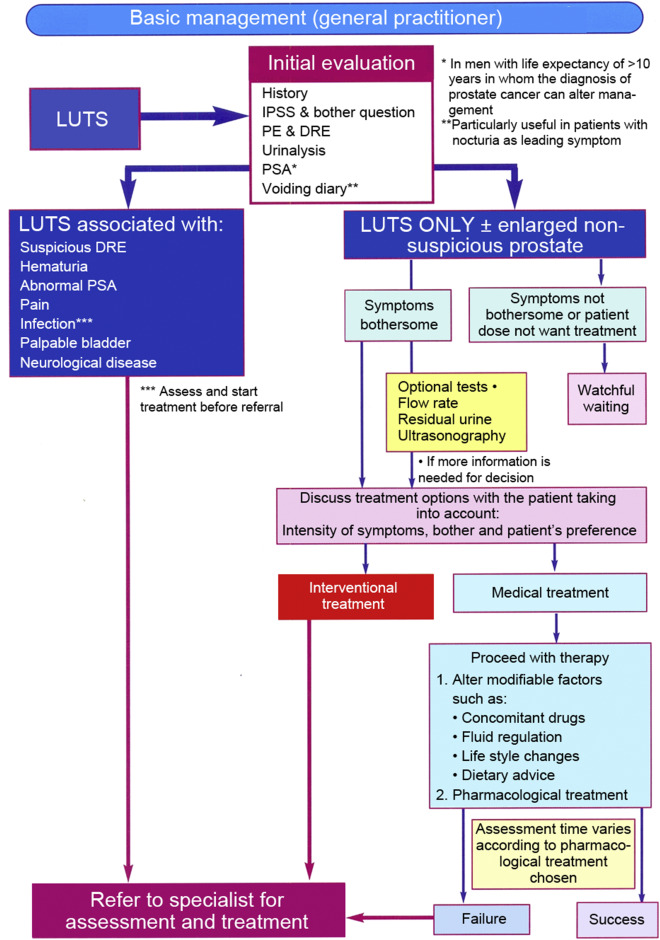
Management of BPH then 2000 and now 2016-From BPH to BPO
Johan Braeckman, Louis Denis
Asian Journal of Urology, 2017, 4(3): 138-147.
doi:10.1016/j.ajur.2017.02.002
 摘要
摘要
(
531 )
 PDF
PDF (4988KB)
(
70
)
The diagnosis and treatment of benign prostatic obstruction (BPO) is based on a number of well-known lower urinary tract symptoms (LUTS) feared by all ageing males with functional testes. The ascent of modern urology turned this disease from lethal into an annoying but treatable health problem in the previous century. We are able to relieve the great majority of patients from their bothersome symptoms to a respectable quality of life by medication or removal of the obstructive part of the enlarged prostate. We can be proud of some progress made in the new millennium to reach a correct diagnosis and subsequent choice of treatment aiming for quality of life and cost-efficiency for public health. Still it remains symptomatic treatment and we expect the new generation of urologists to close some gaps in our knowledge on the regulation of prostatic growth to focus on prevention and elimination of the disease in the foreseeable future.
参考文献 |
相关文章 |
计量指标
|
|
|
Epidemiology of clinical benign prostatic hyperplasia
Kok Bin Lim
Asian Journal of Urology, 2017, 4(3): 148-151.
doi:10.1016/j.ajur.2017.06.004
 摘要
摘要
(
471 )
 PDF
PDF (314KB)
(
76
)
Clinical benign prostatic hyperplasia (BPH) is one of the most common diseases in ageing men and the most common cause of lower urinary tract symptoms (LUTS). The prevalence of BPH increases after the age of 40 years, with a prevalence of 8%-60% at age 90 years. Some data have suggested that there is decreased risk among the Asians compared to the western white population. Genetics, diet and life style may play a role here. Recent reports suggest the strong relationship of clinical BPH with metabolic syndrome and erectile dysfunction, as well as the possible role of inflammation as a cause of the prostatic hyperplasia. Lifestyle changes including exercise and diet are important strategies in controlling this common ailment.
参考文献 |
相关文章 |
计量指标
|
|
|
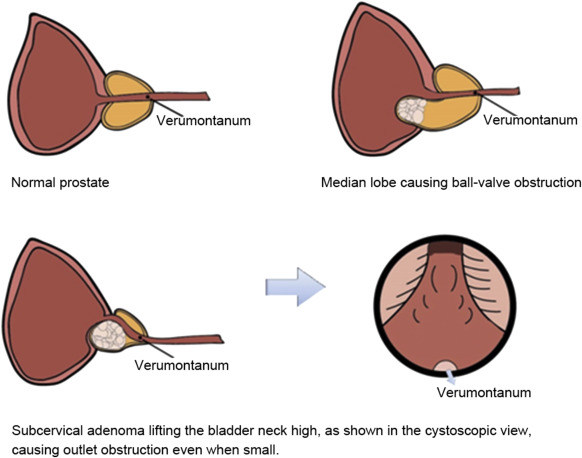
Pathophysiology of clinical benign prostatic hyperplasia
Keong Tatt Foo
Asian Journal of Urology, 2017, 4(3): 152-157.
doi:10.1016/j.ajur.2017.06.003
 摘要
摘要
(
558 )
 PDF
PDF (5383KB)
(
71
)
A disease can be defined as an abnormal anatomy (pathology) and/or function (physiology) that may cause harm to the body. In clinical benign prostatic hyperplasis (BPH), the abnormal anatomy is prostate adenoma/adenomata, resulting in a varying degree of benign prostatic obstruction (BPO) that may cause harm to the bladder or kidneys. Thus clinical BPH can be defined as such and be differentiated from other less common causes of male lower urinary tract symptoms. Diagnosis of the prostate adenoma/adenomata (PA) can be made by measuring the intravesical prostatic protrusion (IPP) and prostate volume (PV) with non-invasive transabdominal ultrasound (TAUS) in the clinic. The PA can then be graded (phenotyped) according to IPP and PV. Multiple studies have shown a good correlation between IPP/PV and BPO, and therefore progression of the disease. The severity of the disease clinical BPH can be classified into stages from stage I to IV for further management. The classification is based on the effect of BPO on bladder functions, namely that of emptying, normal if postvoid residual urine (PVRU) < 100 mL; and bladder storage, normal if maximum voided volume (MVV) > 100 mL. The effect of BPO on quality of life (QoL) can be assessed by the QoL index, with a score ≥ 3 considered bothersome. Patients with no significant obstruction and no bothersome symptoms would be stage I; those with no significant obstruction but has bothersome symptoms (QoL ≥ 3) would be stage Ⅱ; those with significant obstruction (PVRU > 100 mL; or MVV < 100 mL), irrespective of symptoms would be stage Ⅲ; those with complications of the disease clinical BPH such as retention of urine, bladder stones, recurrent bleeding or infections would be stage IV. After assessment, further management can then be individualised. A low grade and stage disease can generally be watched (active surveillance) while a high grade and stage disease would need more invasive management with an option for surgery. The final decision making would take into account the patient's age, co-morbidity, social economic background and his preferences/values. Proper understanding of pathophysiology of clinical BPH would lead to better selection of patients for individualised and personalised care and more cost effective management.
参考文献 |
相关文章 |
计量指标
|
|
|
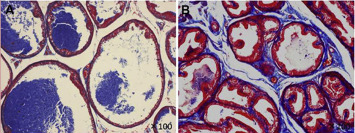
The influence of asymptomatic inflammatory prostatitis on the onset and progression of lower urinary tract symptoms in men with histologic benign prostatic hyperplasia
Rikiya Taoka, Yoshiyuki Kakehi
Asian Journal of Urology, 2017, 4(3): 158-163.
doi:10.1016/j.ajur.2017.02.004
 摘要
摘要
(
532 )
 PDF
PDF (1530KB)
(
458
)
Benign prostatic hyperplasia (BPH) is a condition that greatly affects the quality of life of middle-aged and elderly men. Histopathologically, hyperplastic changes frequently occur in the prostate tissue of elderly men, the incidence of which has been reported to reach approximately 80% in men in their 70s. In clinical practice, approximately 25% of men with histologic BPH are assumed to experience lower urinary tract symptoms (LUTS) and receive some kind of treatment. In other words, there are some men with histologic BPH who do not exhibit LUTS. For that reason, many factors, such as the change in hormonal environment, the immune or autoimmune response, the alteration of gene expression, and so on, are thought to affect the onset and progression of LUTS in men with histologic BPH. One such factor that has long drawn attention is the presence of asymptomatic histological inflammation, which very often accompanies symptomatic BPH. Recent studies have suggested that asymptomatic histological inflammation causes repeated destruction, healing, and regeneration of the prostate tissue, leading to the enlargement of prostatic nodules, while at the same time causing stromal tissuepredominant remodeling of the prostate tissue, which can increase urination resistance and result in the condition changing from asymptomatic BPH to symptomatic BPH. In future, the biomolecular clarification of the significance of asymptomatic histological inflammation in the prostate tissue could help develop new treatment strategies for BPH accompanied by LUTS.
参考文献 |
相关文章 |
计量指标
|
|
|
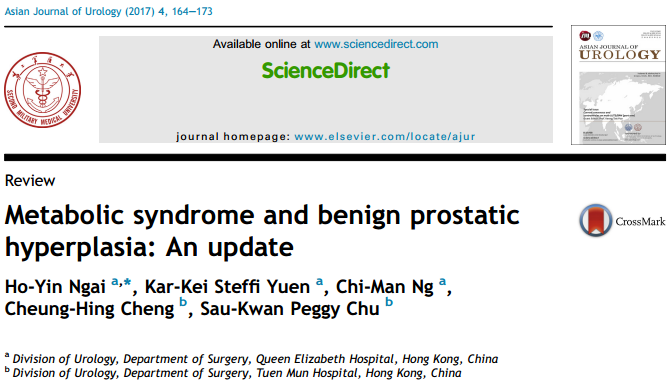
Metabolic syndrome and benign prostatic hyperplasia:An update
Ho-Yin Ngai, Kar-Kei Steffi Yuen, Chi-Man Ng, Cheung-Hing Cheng, Sau-Kwan Peggy Chu
Asian Journal of Urology, 2017, 4(3): 164-173.
doi:10.1016/j.ajur.2017.05.001
 摘要
摘要
(
453 )
 PDF
PDF (364KB)
(
55
)
Metabolic syndrome (MetS) is a cluster of metabolic abnormalities related to central adiposity and insulin resistance. Its importance is increasingly recognized as it associates with increased risks of metabolic and cardiovascular diseases. These metabolic aberrations of MetS may lead to development of benign prostatic hyperplasia (BPH) and lower urinary tract symptoms (LUTS) in men. A 26.5%-55.6% prevalence of MetS in men with LUTS was reported in worldwide studies. Although the exact biological pathway is not clear yet, insulin resistance, increased visceral adiposity, sex hormone alterations and cellular inflammatory reactions played significant roles in the related pathophysiological processes. Clinician should recognize the cardiovascular and metabolic impacts of MetS in men with LUTS, early risk factors optimization and use of appropriate medical therapy may possibly alter or slower the progression of LUTS/BPH, and potentially avoid unnecessary morbidities and mortalities from cardiovascular and metabolic diseases for those men.
参考文献 |
相关文章 |
计量指标
|
|
|

Clinical value of intravesical prostatic protrusion in the evaluation and management of prostatic and other lower urinary tract diseases
Darab Mehraban
Asian Journal of Urology, 2017, 4(3): 174-180.
doi:10.1016/j.ajur.2016.10.001
 摘要
摘要
(
413 )
 PDF
PDF (344KB)
(
51
)
Intravesical prostatic protrusion (IPP) has emerged as a new prostatic morphometric parameter of significance to aid the clinicians in various aspects of managing the patients with some diseases of the lower urinary tract and the prostate. These include but may not be limited to its role in such conditions as:bladder outlet obstruction, trial without catheter, medical treatment effect, progression of lower urinary tract symptoms related to benign prostatic hypertrophy (LUTS/BPH), risk factor for bladder stone in BPH, overactive bladder, prostate carcinoma, and early urinary continence recovery after laparoscopic radical prostatectomy. In this review, I will try to summarize the different researchers' efforts on the potential practical application of this clinical tool. Technology is ever evolving to help us in the diagnosis and management of our patients. However, we as clinicians should contemplate their cost and possible suffering for the patient by wise and judicious utilization based on our clinical experience and tools. IPP seems to be one such promising clinical tool.
参考文献 |
相关文章 |
计量指标
|
|
|
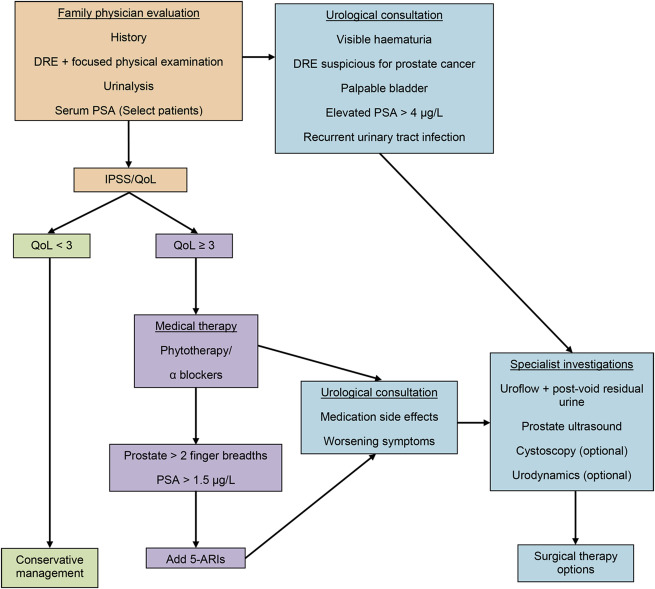
Benign prostatic hyperplasia and male lower urinary symptoms:A guide for family physicians
Farhad Fakhrudin Vasanwala, Michael Yuet Chen Wong, Henry Sun Sien Ho, Keong Tatt Foo
Asian Journal of Urology, 2017, 4(3): 181-184.
doi:10.1016/j.ajur.2017.05.003
 摘要
摘要
(
396 )
 PDF
PDF (1633KB)
(
57
)
Male patients with lower urinary tract symptoms (LUTS) and benign prostatic hyperplasia (BPH) are increasingly seen by family physicians worldwide due to ageing demographics. A systematic way to stratify patients who can be managed in the community and those who need to be referred to the urologist is thus very useful. Good history taking, physical examination, targeted blood or urine tests, and knowing the red flags for referral are the mainstay of stratifying these patients. Case selection is always key in clinical practice and in the setting of the family physician. The best patient to manage is one above 40 years of age, symptomatic with nocturia, slower stream and sensation of incomplete voiding, has a normal prostatespecific antigen level, no palpable bladder, and no haematuria or pyuria on the labstix. The roles of α blockers, 5-α reductase inhibitors, and antibiotics in a primary care setting to manage this condition are also discussed.
参考文献 |
相关文章 |
计量指标
|
|
|
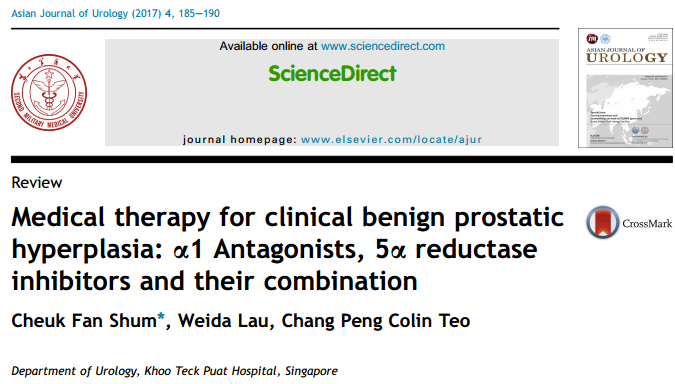
Medical therapy for clinical benign prostatic hyperplasia:a1 Antagonists, 5a reductase inhibitors and their combination
Cheuk Fan Shum, Weida Lau, Chang Peng Colin Teo
Asian Journal of Urology, 2017, 4(3): 185-190.
doi:10.1016/j.ajur.2017.06.002
 摘要
摘要
(
520 )
 PDF
PDF (329KB)
(
272
)
Medical therapy for clinical benign prostatic hyperplasia (BPH) has advanced significantly in the last 2 decades. Many new α1 antagonists and 5α reductase inhibitors (5ARi) are now commercially available. The practicing urologist must decide on the most appropriate medication for his patients, taking into consideration various factors like efficacy, dosing regime, adverse effects, cost, patient's socioeconomic background, expectations, drug availability and his own clinical experience. The use of combination therapy added further to the complexity in clinical judgment when prescribing. We highlight some of the key points in prescribing α1 antagonists, 5ARi and their combination, based on our viewpoints and experience as urologists in an Asian clinical setting.
参考文献 |
相关文章 |
计量指标
|
|
|
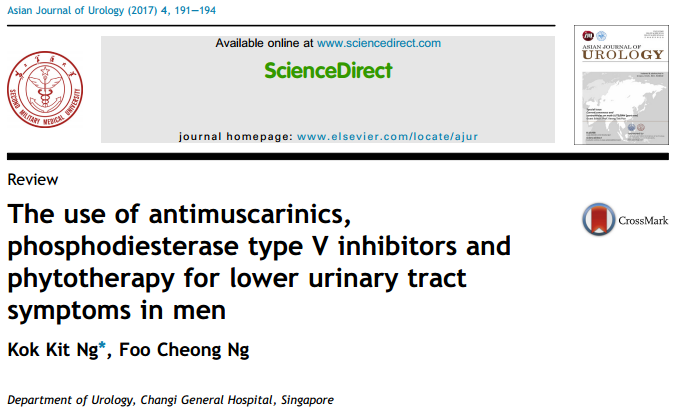
The use of antimuscarinics, phosphodiesterase type V inhibitors and phytotherapy for lower urinary tract symptoms in men
Kok Kit Ng, Foo Cheong Ng
Asian Journal of Urology, 2017, 4(3): 191-194.
doi:10.1016/j.ajur.2017.05.002
 摘要
摘要
(
473 )
 PDF
PDF (314KB)
(
1104
)
Besides the mainstay of α-blockers and 5α-reductase inhibitors, other forms of medical therapy complete the armamentarium in the treatment of lower urinary tract symptoms (LUTS) in men. These treatments can target specific symptoms as well as associated symptoms that would affect the quality of life of the patients. Many patients are bothered by storage symptoms, more so than the voiding symptoms. Antimuscarinics are efficacious and safe, provided the patients do not have high post void residual urine. Many patients with LUTS also have erectile dysfunction, and phosphodiesterase type V inhibitors are effective in relieving both LUTS as well as erectile dysfunction for such patients. Phytotherapy provides a popular and safe treatment for LUTS, however, the efficacy of the treatment has not been proven in well conducted prospective randomized controlled studies.
参考文献 |
相关文章 |
计量指标
|
|
|
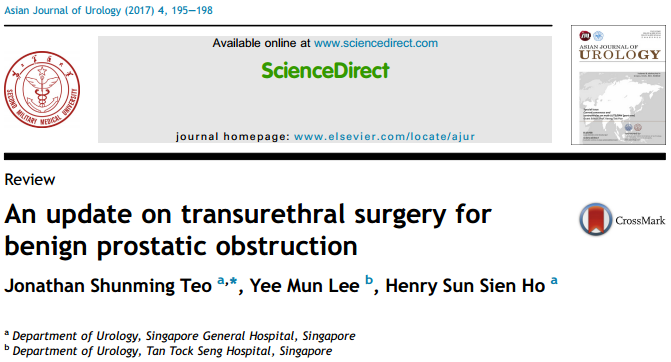
An update on transurethral surgery for benign prostatic obstruction
Jonathan Shunming Teo, Yee Mun Lee, Henry Sun Sien Ho
Asian Journal of Urology, 2017, 4(3): 195-198.
doi:10.1016/j.ajur.2017.06.006
 摘要
摘要
(
531 )
 PDF
PDF (318KB)
(
356
)
Clinical benign prostatic hyperplasia (BPH) is one of the most common cause of lower urinary tract symptoms and transurethral resection of prostate (TURP) has been the gold standard technique for surgical treatment of benign prostate obstruction (BPO) over the last 2 decades. Although monopolar TURP is considered a safe and effective option for surgical management of BPO, there are some disadvantages, namely bleeding, transurethral resection syndrome, incompleteness of treatment. This review aims to highlight these problems, and describe the advances in technology and techniques that have evolved to minimise such complications. With the advent of lasers and bipolar technology, as well as enucleative techniques to remove the prostatic adenoma/adenomata, the problems of bleeding, transurethral resection syndrome and incomplete treatment are significantly minimised. Monopolar TURP will likely be replaced by such technology and techniques in the near future such that transurethral surgery of the prostate remain a safe and effective option in alleviating the harmful effects of BPO.
参考文献 |
相关文章 |
计量指标
|
|
 当期目录
当期目录
